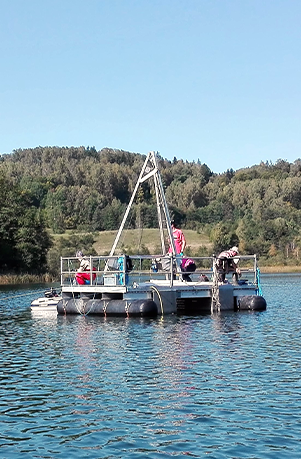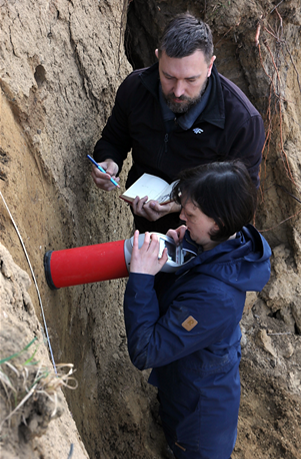Katedra Geomorfologii i Geologii Czwartorzędu kontynuuje tradycję badań geomorfologicznych Pomorza zapoczątkowanych w 1959 roku przez profesora Bolesława Augustowskiego. Kolejno kierownikami zespołu geomorfologów byli profesorowie: Bogusław Rosa (1970–1996), Roman Gołębiewski (1996–2008) oraz Stanisław Fedorowicz (2008–2022). Tematyka prowadzonych badań obejmowała kartowanie geomorfologiczne obszarów pojeziernych, zagadnienia morfologii i genezy sieci dolinnej Pomorza, badania struktury pokrywy osadowej dna południowego Bałtyku, zagadnienia chronostratygrafii neoplejstocenu przy zastosowaniu metody TL, a także badania paleogeograficzne na podstawie analiz palinologicznych i okrzemkowych.
Obecnie kierownikiem Katedry jest profesor Wojciech Tylmann. W wyniku ewolucji problematyki badawczej i stopniowej specjalizacji naukowców w strukturze katedry wyłoniły się dwa niezależne zespoły badawcze: Pracownia Badań Paleośrodowiskowych oraz Pracownia Rekonstrukcji Geomorfologicznych.
Pracownia Badań Paleośrodowiskowych prowadzi badania zmian środowiska, które zachodziły w przeszłości, a możliwe są do odtworzenia na podstawie analiz osadów jeziornych oraz torfowych. Koncentrujemy się na zmianach zachodzących pod wpływem czynników klimatycznych oraz działalności człowieka w okresie ostatnich kilkunastu tysięcy lat. Do właściwej interpretacji zapisu kopalnego niezbędna jest również wiedza na temat procesów prowadzących do formowania osadów. Dlatego też badania uwarunkowań współczesnej sedymentacji osadów w jeziorach stanowią równie ważny kierunek badawczy naszego zespołu. Wykorzystujemy głownie metody geochronologiczne, sedymentologiczne i geochemiczne. Z uwagi na interdyscyplinarny charakter naszych badań współpracujemy z wieloma ośrodkami w zakresie wykorzystania metod paleobiologicznych oraz izotopów stabilnych. Naszym głównym obszarem badawczym jest północna Polska, ale uczestniczymy również w badaniach jezior w Europie, Afryce, Ameryce Południowej, Ameryce Północnej, Australii i Azji.

Pracownia Rekonstrukcji Geomorfologicznych prowadzi badania dawnych oraz współczesnych procesów rzeźbotwórczych. Główna uwaga zespołu skupia się na środowiskach lądowych, zwłaszcza związanych z obecnością lodowców i lądolodów, ale ważnymi dla nas obszarami są także wybrzeża morskie. Angażujemy się również w prace naukowe w stanowiskach archeologicznych. Wykorzystujemy nowatorskie metody badawcze i wysokorozdzielcze dane przestrzenne, aby odtworzyć warunki powstania rzeźby oraz procesy sterujące jej ewolucją. Dzięki temu staramy się wnosić wkład do wiedzy na temat prawidłowości rządzących zjawiskami naturalnymi oraz do jej zastosowania w praktyce, np. do zabezpieczania się przed skutkami zagrożeń naturalnych. Nasze badania obejmują analizę morfologii i układu form rzeźby, rozpoznanie struktur widocznych w odsłonięciach geologicznych, analizę składu petrograficznego, mineralnego i geochemicznego osadów oraz ich właściwości geofizycznych. Określamy również wiek i następstwo zdarzeń w przeszłości, wykorzystując różne metody datowań osadów i procesów. Współpracujemy z wieloma ośrodkami naukowymi w kraju i zagranicą. Naszym głównym obszarem badawczym jest środkowa i północna Europa, w tym Morze Bałtyckie, ale bierzemy także udział w badaniach na innych kontynentach.
